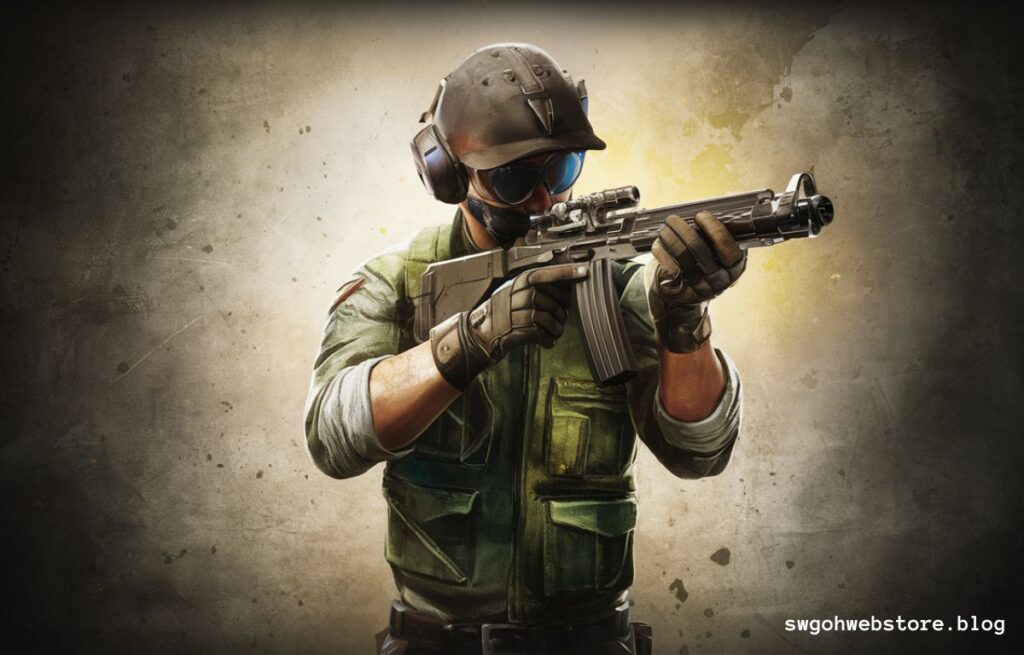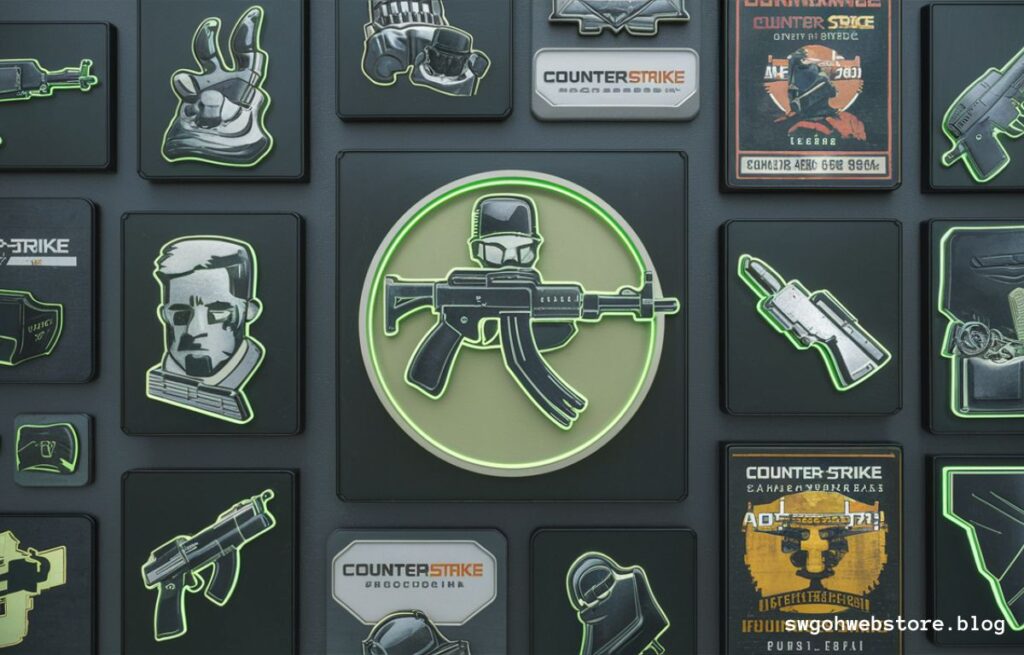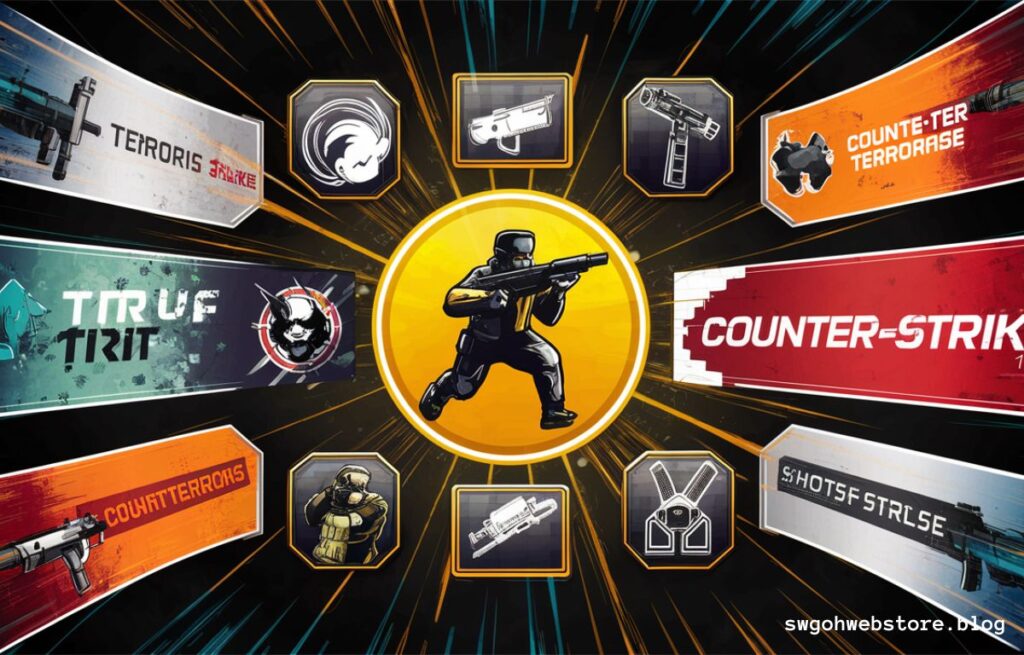Counter-Strike 1.6, launched in 2003, changed the world of first-person shooter games. As a Half-Life mod, it quickly became a favorite among gamers. The game’s unique icons and banners were key to its charm and appeal. These visuals made the game stand out and become memorable.
The game icons in Counter-Strike 1.6 were more than just images. They represented the two main teams: Counter-Terrorists and Terrorists. The Counter-Terrorists icon was a cool blue soldier, symbolizing order and discipline. On the other hand, the Terrorists icon was a fiery red figure, showcasing a wild and chaotic style.
Banners in Counter-Strike 1.6 added to the game’s immersive experience. They weren’t just decorations; they helped build the game’s intense atmosphere. Players instantly recognized these banners, which often featured action-packed scenes and dynamic characters. This made every game moment feel exciting and real.
Overall, the game icons and banners in Counter-Strike 1.6 played a big role in its success. They helped create a strong identity for the game, making it easy to remember and love. These visuals not only looked good but also enhanced the gameplay, making Counter-Strike 1.6 a true classic.
The Evolution of counter-strike 1.6 (2003) game icons banners
Counter-strike 1.6 (2003) game icons banners evolved significantly over time. Initially, they were simple designs that served basic purposes. As the game grew, these icons became more detailed and meaningful. This evolution mirrored the game’s development and increasing complexity.
The Counter-Terrorist (CT) and Terrorist (T) icons became the most recognizable symbols. The CT icon, usually in cool blue tones, represented a disciplined soldier ready for action. It symbolized professionalism and order. In contrast, the T icon, often in fiery reds, depicted a rugged guerrilla fighter, emphasizing chaos and aggression.
These icons weren’t just team indicators; they became emblems of the game’s core conflict. Players instantly understood the roles and strategies associated with each team. The clear visual distinction helped players quickly identify allies and enemies during intense matches.
The evolution of these icons played a crucial role in enhancing the overall gaming experience. As they became more detailed and expressive, they added depth to the game’s narrative. This visual development contributed to Counter-Strike 1.6’s lasting impact and popularity in the gaming community.
Gameplay Mechanics and Quality That Made Counter-Strike 1.6 a Hit

Counter-Strike 1.6 was famous for its tactical gameplay and teamwork. Players couldn’t win by going solo; they needed to work together. Communication and coordination were key to outsmarting the enemy. This focus on teamwork set it apart from other shooters.
Each match had clear objectives that guided the action. Terrorists aimed to plant bombs or hold hostages, while Counter-Terrorists tried to stop them. These goals added layers of strategy beyond just shooting enemies. Players had to plan and execute their moves carefully.
The in-game economy system was another standout feature. Players earned money based on their performance, like winning rounds or getting kills. This money was used to buy better weapons and equipment. Managing finances added a strategic element to the game, as players had to decide between saving or spending.
Also Read: Enhancing get_ready_bell:client_pulse
Weapon variety and balance were crucial to the game’s appeal. Each weapon had unique strengths and weaknesses, encouraging players to master different guns. From pistols to rifles, every choice mattered. This balance ensured that no single weapon dominated, keeping the gameplay fair and exciting.
Weapon Variety and Balance
Counter-Strike 1.6 offered a wide range of weapons for players to choose from. Each gun had its own strengths and weaknesses, making gameplay diverse and strategic. Players had to master various firearms, from pistols to powerful rifles, to succeed in different situations. This variety kept the game interesting and engaging.
The balance between weapons was crucial to maintaining fair gameplay. No single weapon was overly powerful, so players had to rely on skill rather than just firepower. For example, the AK-47 and M4A1 were both strong but required different handling. This balance encouraged players to become proficient with multiple weapons.
Grenades and equipment added another layer of strategy. Players could buy flashbangs, smoke grenades, and HE grenades to gain a tactical advantage. Using these tools effectively could change the outcome of a round. A well-placed smoke grenade could obscure vision, while a flashbang could blind opponents, creating opportunities for strategic plays.
The careful design of the weapon system ensured that every match was unique. Players had to adapt their strategies based on the weapons and equipment they had. This dynamic gameplay, supported by balanced weapons and tactical tools, was a key factor in making Counter-Strike 1.6 a timeless classic.
Skill-Based Mechanics
Counter-Strike 1.6 stood out for its high skill ceiling, rewarding players who mastered its mechanics. Each gun had a unique recoil pattern, requiring players to practice and perfect their aim. Learning to control this recoil was crucial for accurate shooting, adding depth to the gameplay.
Movement and positioning were equally important in CS 1.6. Players had to know when to run, walk, or crouch to gain the upper hand. Smart positioning, like taking cover or holding strategic points, often meant the difference between victory and defeat. This added a layer of strategy beyond just shooting skills.
The game also featured advanced techniques that skilled players could use. For example, “Russian walking” allowed players to move silently at near-running speed by tapping the walk key. Another technique, the “Crabwalk,” involved shooting while ducked and moving, providing surprising accuracy. Mastering these skills took time and practice.
Sound played a critical role in the game, too. Players had to listen carefully for footsteps, gunshots, and other audio cues to anticipate enemy movements. This reliance on sound added another dimension to the gameplay, making awareness and quick reactions essential for success.
Community and Mod Support

Counter-Strike 1.6 thrived thanks to its vibrant community and extensive mod support. Players around the world contributed to the game’s evolution by creating custom maps and mods. This community-driven content kept the game fresh and exciting, offering new challenges and experiences.
The modding scene in CS 1.6 was incredibly creative. Players designed new game modes that added variety to the standard gameplay. For example, the “Warcraft 3” mod introduced character classes and special abilities, blending FPS action with RPG elements. Another popular mod, “Zombie Escape,” turned the game into a cooperative survival challenge.
Custom maps became iconic within the CS 1.6 community. Maps like de_dust2 were played countless times, becoming staples of the game. These player-created maps often had unique layouts and strategies, providing endless hours of fun. The ability to create and share maps helped foster a strong and dedicated player base.
Also Read: The Ultimate Guide to Cute:bikwq7id6hy= Kirby
The game’s openness to mods and custom content significantly extended its lifespan. Players weren’t just consumers; they were also creators, shaping the game’s future. This collaborative environment not only enhanced the gameplay experience but also built a lasting, engaged community that kept Counter-Strike 1.6 alive for many years.
Competitive Scene
Counter-Strike 1.6 wasn’t just a popular game; it became a cornerstone of competitive gaming. The game’s balanced mechanics and high skill ceiling made it perfect for esports. Tournaments drew large crowds, both in-person and online, creating a thriving competitive scene.
Early on, CS 1.6 tournaments started small but quickly grew in scale. Players formed teams and competed for prizes, prestige, and the thrill of victory. These competitions showcased the game’s depth and the players’ skills, turning top players into gaming celebrities.
The rise of competitive CS 1.6 also led to the development of professional esports organizations. Teams trained rigorously, honing their strategies and teamwork to outplay their opponents. This professionalization helped elevate esports, demonstrating that gaming could be a serious and organized sport.
The impact of CS 1.6 on the competitive gaming world is still felt today. It paved the way for modern esports, influencing how tournaments are run and how players train. The game’s legacy lives on, inspiring new generations of competitive gamers and maintaining a strong community of dedicated fans.
Thrilling Game Modes That Kept Players Hooked on Counter-Strike 1.6
Counter-Strike 1.6 offered a variety of game modes that kept players coming back for more. The classic bomb defusal and hostage rescue modes were the core of the game. In bomb defusal, Terrorists tried to plant and detonate a bomb while Counter-Terrorists worked to stop them. Hostage rescue had CTs attempting to save hostages from the Terrorist team. These modes required strategic thinking and teamwork.
Beyond the standard modes, the community created custom game modes that added even more fun. Deathmatch was fast-paced and perfect for practicing aim. Gun Game challenged players to get kills with every weapon in the game, adding a unique twist. Zombie mode turned the game into a thrilling survival horror experience, with players fighting off infected teammates.
Competitive and community-driven modes also played a big part in the game’s appeal. Capture the Flag introduced new objectives, requiring players to steal the enemy’s flag and return it to their base. Surf maps pushed the boundaries of the game’s physics, offering a whole new way to play by navigating through complex courses using momentum and skill.
These diverse game modes, both official and community-created, kept Counter-Strike 1.6 fresh and exciting. They showcased the game’s versatility and the creativity of its player base. This variety ensured that there was always something new and engaging for players to explore, contributing to the game’s lasting popularity.
Banners that Defined a Generation
In Counter-Strike 1.6, banners were more than just visual elements—they were symbols of the game’s culture and community.
Iconic Moments: Banners like “Door Stuck” immortalized memorable in-game moments, showcasing the game’s unpredictable and humorous side.
Map Recognition: The “Dust 2 Doors” banner became a test of veteran players’ knowledge, identifying different versions of the map based on door designs alone.
Community Identity: Custom banners for clans and communities fostered a sense of belonging and pride, featuring unique logos and color schemes.
Competitive Spirit: Tournament banners hyped up events with dynamic graphics, dates, and logos, celebrating the competitive spirit that defined CS 1.6.
These banners weren’t just decorations; they were a visual language that united players worldwide, reflecting the game’s rich history and enduring legacy.
The Legacy of Counter-Strike 1.6

Counter-Strike 1.6 left an indelible mark on gaming culture that continues to resonate today.
Foundational Influence: Its emphasis on skill-based gameplay and tactical depth set a standard for competitive shooters, influencing many modern FPS games.
Esports Pioneering: CS 1.6 laid the groundwork for esports as we know it, with its structured gameplay and high-stakes tournaments attracting massive audiences.
Modding Community: The game’s robust modding support sparked creativity and innovation, birthing new game modes and maps that expanded its lifespan.
Cultural Icon: Beyond its gameplay, CS 1.6 became a cultural touchstone, recognized for its memorable sounds, iconic maps like de_dust2, and community-driven spirit.
Also Read: The Concept Behind treeleftbig.shop
Even as newer titles emerge, Counter-Strike 1.6 remains a beloved classic, cherished for its enduring gameplay, community engagement, and lasting impact on the gaming industry.
Conclusion: The Enduring Legacy of Counter-Strike 1.6
Counter-Strike 1.6 isn’t just a game; it’s a legend that shaped the landscape of gaming forever. From its humble beginnings as a Half-Life mod to becoming a global phenomenon, CS 1.6 defined what it means to be a tactical shooter and a community-driven experience.
Cultural Impact: Its distinctive gameplay mechanics, including tactical depth, precise gunplay, and strategic teamwork, set a new standard in the FPS genre. The game’s iconic maps, like de_dust2, and memorable sound effects became ingrained in gaming culture, recognized and revered by players worldwide.
Esports Pioneer: CS 1.6 pioneered competitive gaming, laying the foundation for modern esports. Its structured gameplay, clear objectives, and high skill ceiling attracted a passionate competitive scene that continues to thrive today. The game’s tournaments became arenas where legends were born, inspiring future generations of professional gamers.
Community Legacy: Beyond its gameplay, CS 1.6 thrived on its vibrant community and modding support. Players not only played the game but also shaped its evolution through custom maps, mods, and memorable banners. This community-driven creativity extended its lifespan and fostered a deep sense of belonging among players.
Enduring Appeal: Even decades after its release, Counter-Strike 1.6 remains a timeless classic. Its accessibility, strategic depth, and balanced gameplay continue to attract players old and new. LAN parties and small tournaments still feature the game, showcasing its lasting impact and intergenerational appeal.
In conclusion, Counter-Strike 1.6 isn’t just a game of its time; it’s a cultural icon that continues to influence gaming today. Its legacy of innovation, community engagement, and competitive spirit continues to resonate, proving that great gameplay transcends generations and technological advancements. Here’s to Counter-Strike 1.6 – a true legend in the world of gaming.
Frequently asked questions (FAQs) about Counter-Strike 1.6:
What is Counter-Strike 1.6?
Counter-Strike 1.6 is a tactical first-person shooter game originally developed as a Half-Life mod. It was released in 2003 and quickly gained popularity for its strategic gameplay and competitive multiplayer modes.
What are the main game modes in Counter-Strike 1.6?
The main game modes include bomb defusal, where terrorists plant bombs and counter-terrorists defuse them, and hostage rescue, where counter-terrorists rescue hostages held by terrorists. There are also custom game modes created by the community, such as deathmatch and gun game.
What made Counter-Strike 1.6 popular?
Counter-Strike 1.6 became popular due to its balanced gameplay, emphasis on teamwork and strategy, and the ability for players to create and share custom content like maps and mods. It also contributed significantly to the growth of esports.
Can Counter-Strike 1.6 be played competitively?
Yes, Counter-Strike 1.6 has a strong competitive scene with tournaments held worldwide. Professional players compete in teams, showcasing their skills in organized matches with spectators and prize pools.
What impact did Counter-Strike 1.6 have on gaming culture?
Counter-Strike 1.6 had a profound impact on gaming culture by popularizing tactical shooters and competitive gaming. It introduced gameplay mechanics and community-driven content creation that influenced subsequent FPS games and esports.
Is Counter-Strike 1.6 still played today?
Yes, Counter-Strike 1.6 still has an active player base and is played globally. It continues to be enjoyed for its classic gameplay, low system requirements, and the nostalgia it brings to longtime fans.

Emily, an 8-year veteran, blends tech savvy with wanderlust. His fashion-forward perspective and business acumen create captivating content. Explore realms where innovation meets style.